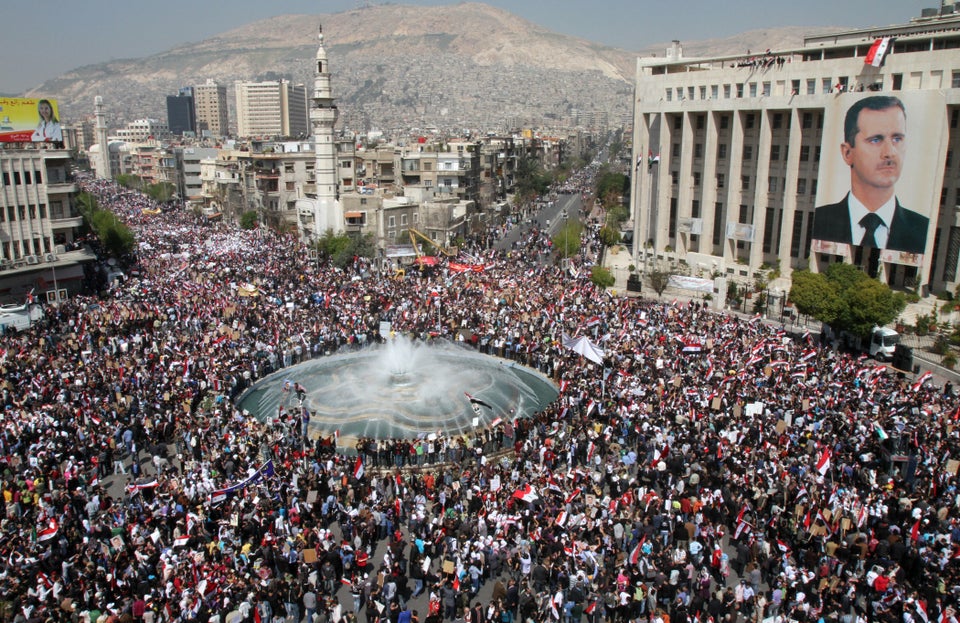
After more than two years of brutal conflict, there is no end in sight for the bloody war between the regime of President Bashar Assad and opposition fighters.
The United Nations estimates that at least 70,000 people have lost their lives since the start of the conflict in March 2011. One million refugees have fled to neighboring countries. Syria's cities are left destroyed, its streets deserted. Homes have been reduced to rubble, schools turned to dust.
HuffPost World takes a look at some of the key events and major players in Syria over over the past 24 months.
THE BEGINNING
Angered by the arrest and torture of teenage boys who had spray-painted anti-government slogans on a city wall, protesters took to the streets in Syria's southern city of Daraa in March 2011. Security forces responded brutally, firing live ammunition and tear gas at the crowds and killing several protesters.
Protests gradually spread to other cities and the regime, too, stepped up its response. Assad offered concessions, but maintained his innocence and claimed that foreign agents were to blame for the unrest. Unimpressed by the government's offer, protests intensified during the spring and summer of 2011, and so did the regime's harsh repression of the demonstrations.
The violence reached new heights toward the end of 2011 as the conflict militarized. A growing number of defectors -- loosely organized in the Free Syrian Army -- staged guerrilla attacks against Assad's troops. Bombs targeting security forces and regime functionaries killed dozens in Aleppo and the capital, Damascus, throughout the spring. A major bomb blast targeting a high-level security meeting in July 2012 killed the country's minister of defense and the president's brother-in-law.
GRUESOME KILLINGS, BRUTAL ASSAULTS, CITY WAR
In February 2012, regime forces launched a brutal assault on the rebel-held neighborhood of Baba Amr in the city of Homs. Bombs and rockets rained down on the city for weeks, killing hundreds of people -- many of them civilians. The regime eventually pushed out the fighters, and the strategic victory was followed by attacks on the rebel strongholds of Idlib and Daraa.
Having significantly grown in numbers, rebels opened two new fronts in the fall of 2012, trying to capture neighborhoods in Damascus and Syria's largest city of Aleppo. As violence spread across the country, however, living conditions became increasingly dire. Food and fuel are scarce and bread lines often run for hours. Many hospitals have been destroyed and medicine supplies are at an all-time low. Air strikes and artillery have turned streets into impassable debris, schools have been leveled. Fearing returning airstrikes, some civilians have been forced to take shelter in caves and ancient tombs.
Reports of mass killings by government troops and pro-militiamen began to surface in 2012, around one year into the conflict. Ninety-two people, including more than 30 children, were killed in the town of Houla in the Homs province on May 25. At least 78 were murdered in the hamlet of al Qubair on June 6. Three weeks later, more than 200 people were reportedly slaughtered in the village of Tremseh near Hama. In the winter of 2012, dozens of bodies with gunshot wounds in the head washed up in a river in Aleppo.
However, opposition forces, too, have been accused of perpetrating crimes against government allies. "There may not be anybody with entirely clean hands," Suzanne Nossel, head of Amnesty International, told the Associated Press in November 2012 after a video surfaced that appeared to show Syrian rebels kicking and executing a group of captured soldiers.
REFUGEES
More than a million Syrians have left the country since the start of the conflict, and hundreds of thousands have poured into refugee camps in neighboring Iraq, Jordan, Turkey and Lebanon. "When you stand at the border crossing, you see this human river flowing in, day and night," Panos Moumtzis, the UNHCR regional coordinator for Syrian refugees, told The Associated Press in March 2013. The exodus constitutes one of the worst refugee crises in recent history.
INTERNATIONAL REACTION
While the international community has been harsh on the Syrian regime, urging the embattled Assad to step down, world powers have shown unwillingness to interfere in the Syrian quagmire. European nations and the U.S. have provided humanitarian aid and promised the opposition non-lethal support, but have refused to go as far as to arm the rebels or impose a no-fly zone. Rumors of U.S. trainers aiding Syrian rebels in Jordan persist, however, and France and Britain are mulling whether to supply the rebels with weapons.
Repeated international initiatives to end the bloodshed and force Assad to step down have failed, largely because of Russia's continuing support for the dictator. Russia and China have blocked all significant action through the U.N. Security Council. The brief presence of Arab League and U.N. monitors in Syria also did little to prevent violence.
FOREIGN FIGHTERS
The international community and many inside Syria have become increasingly concerned about the presence of radical foreign militants fighting alongside the rebels. The militants, some of who previously fought in Chechnya and Iraq, aim to create an Islamist society in post-Assad Syria. However, the fighters have proven invaluable in battle and have been responsible for some of the most daring attacks.
The foreigners' presence also raises concerns over renewed sectarian tension in Syria. The majority of Syrians belong to the Sunni Muslim community, but the country also has significant Christian, Shia and Alawite groups. Assad belongs to the Alawite community, a sect that split from Shia Islam and makes up about 12 percent of the population in Syria. Alawites hold many key positions in the Syrian government and the Alawite Assad family has ruled Syria in the past decades by drawing upon the different minority communities, while most members of the opposition today come from the Sunni majority. The radical fighters, too, are believed to belong to the Sunni branch of Islam and are known to carry strong animosity towards the Shia and Alawite branches.
INFORMATION DISSEMINATION
Activists and citizen journalists have distributed hundreds of photos and videos online that often show dead or injured children and civilians, mutilated bodies or destroyed neighborhoods. Yet verifying the content of these reports has proven nearly impossible. Media access has been severely limited in Syria, foreign journalists have been targeted by the regime and opposition fighters alike, Internet access is restricted and local journalists have been suppressed as the opposition and regime present competing narratives of the state of the country. Both Syrian and Western journalists have also been killed in the continuing conflict.
"Plenty of information is coming out from Syria, but the difficulty we find is in verifying the information," Soazig Dollet, head of the Middle East and North Africa desk of Reporters Without Borders, told Al Akhbar, a Lebanese newspaper. "Because of the state’s strict control of traditional media in the country, social media has become our main source of information. However, the question of who is sending out this information remains unanswered," he explained pointedly.
PHOTOS: TWO YEARS OF WAR IN SYRIA

